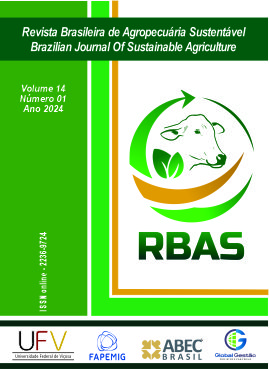português PERFORMANCE OF WHEAT SUBJECTED TO THE APPLICATION OF BIOSTIMULANT BASED ON Ascophyllum nodosum AT DIFFERENT STAGES OF DEVELOPMENT
DOI:
https://doi.org/10.21206/rbas.v14i01.17354Keywords:
Palavras-chave: Deficiência nutricional, bioestimulante, extrato de algas, tratamento de sementes.Abstract
ABSTRACT- The main limiting factor for wheat productivity is nutritional deficiency,
which can cause sterility of the wheat ear pollen, leading to poor grain formation and
productivity losses, in addition to low plant growth and a reduction in the number of
tillers, among others. Thus, the objective of this work was to identify the best period of
development of the wheat crop to apply the biostimulant based on Ascophyllum nodosum,
and analyze the effects on the physiological process of the plant, thus evaluating the
productivity components of the crop, compared to application in seed treatment and
whether there is an effect of this product. The experiment was carried out in a randomized
block design with 4 replications, totaling 28 experimental plots. The 7 treatments tested
were: control, without application of algae extract; application in seed treatment;
application in seed treatment + tillering period of E3; application in the E3 tillering
period; application at the beginning of stretching (E6); seed treatment + stretching (E6);
seed treatment + E3 + E6. After measuring and tabulating the data, the means were
compared using the Tukey test at 5% probability. The treatment that gave the most
expressive results was when applied to TS, due to the influence of root development, due
to the fact that it had a greater absorption of water and nutrients, resulting in greater
productivity.
Keywords: Nutritional deficiency, biostimulant, algae extract, seed treatment.
Downloads
Downloads
Published
How to Cite
Issue
Section
License
Copyright (c) 2024 Brazilian Journal of Sustainable Agriculture

This work is licensed under a Creative Commons Attribution-NonCommercial-NoDerivatives 4.0 International License.
1. Proposta de Política para Periódicos de Acesso Livre
Autores que publicam nesta revista concordam com os seguintes termos:
Autores mantém os direitos autorais e concedem à revista o direito de primeira publicação, com o trabalho simultaneamente licenciado sob a Licença Creative Commons Attribution que permite o compartilhamento do trabalho com reconhecimento da autoria e publicação inicial nesta revista.












